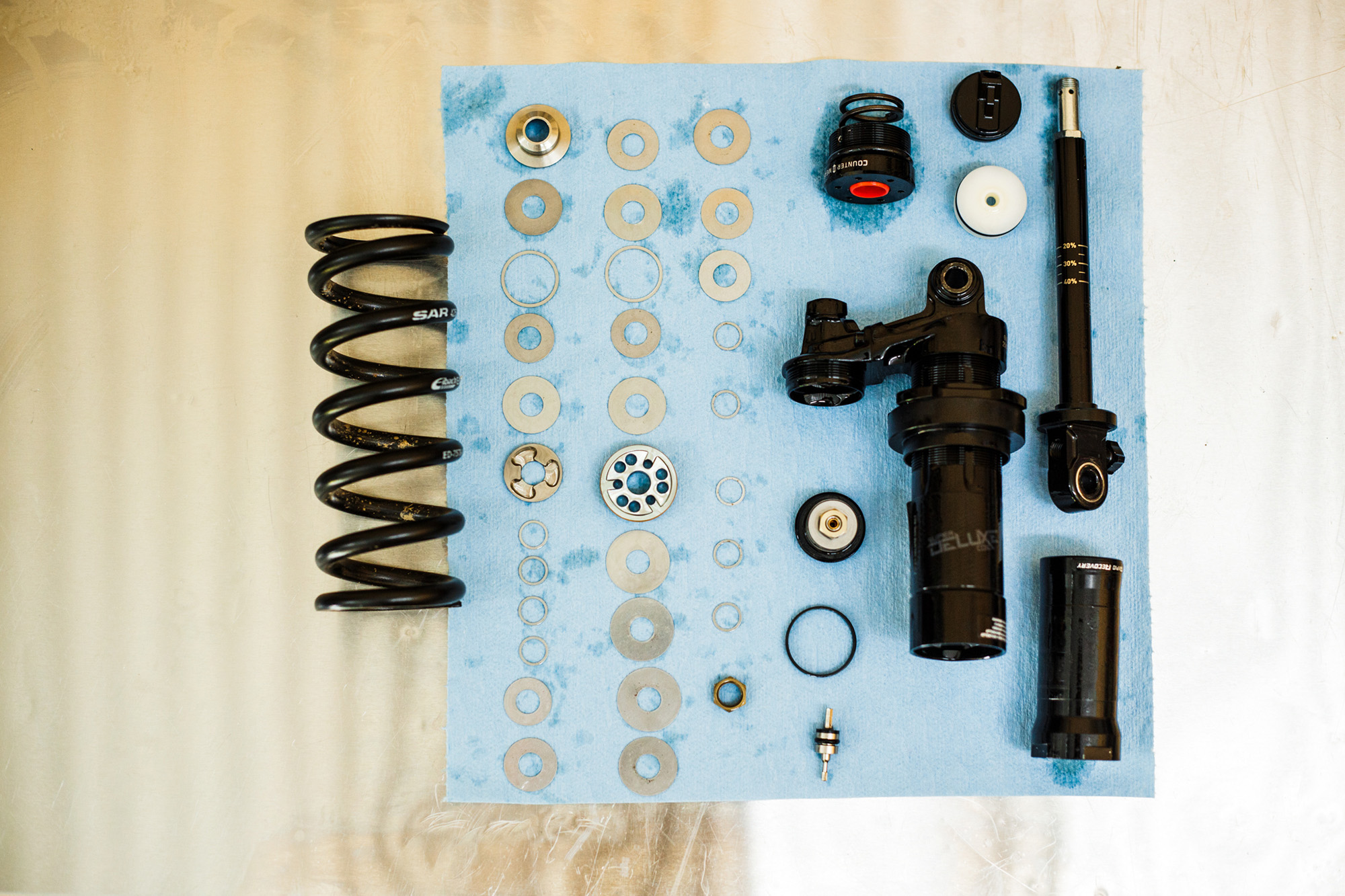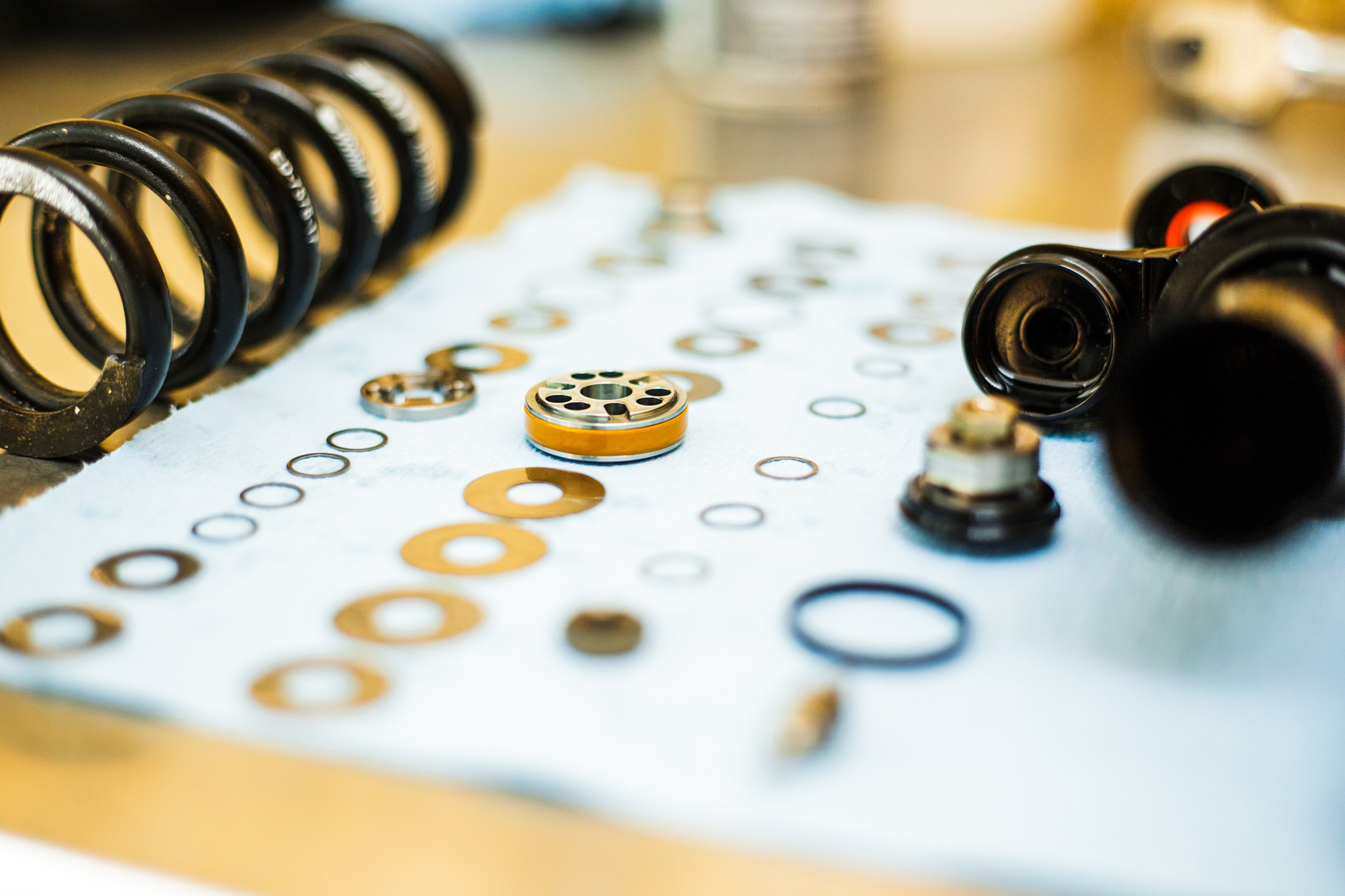Words // Nate @ BikeCo.com
Okay so let’s start with the basic principles to start with; coil springs are rated by the weight that creates an inch of spring compression. A 400lb spring requires 400lbs to compress the first inch. And it takes 800lbs to compress two inches. etc. Coil springs are not produced to “exact” standards. If a coil is offered in 50lb increments (example: 350, 400, 450) a 400lb spring may actually be anywhere from 376 to 425lbs. Most quality spring manufactures have a slightly tighter tolerance, but that’s the concept.
Springs define total length as well as stroke. Running a coil that is too long or short in either measurement can create problems, most often premature coil bind, which limits travel and creates an infinite spring rate when bottomed, which means all your “suspension” is in the tires. I grew up building custom cars and we had to be really aware of this. Now, some auto race teams deliberately bind corners out which is great, except there’s no forgiveness if the tire misbehaves. Anyhow another thing for another day.
A coil spring’s support is based on its diameter (OD and ID), the actual coil’s wire diameter, how much elasticity the material has, how many active coils it has, as well as the angle of the active coils. Understanding coil springs is really an understanding of how the active coils behave, less active coils in a spring increases the resistance to compression. Most MTB springs have closed and ground ends for performance and ease of mount. These wrapped ends do not count as active coils. When a spring is compressed the outer coils contact the wrapped ends. Technically all the coils are compressed equally, but the outer active coils have a lesser distance to the wrapped end coils which is why they make contact and, well, work.
Preload applies additional tension to the spring. It decreases the number of active coils. Tighten the upper spring perch to increase Preload, loosen it to decrease Preload.
As a note – all springs should have at least 1 turn, or 1mm on Fox shocks, of preload to keep the spring in place. Don’t dial in tons of preload turns as it can stress the damper as well as create problems with coil bind if the spring’s freelength is smaller than the stroke of the damper.
Assuming you have a spring with enough stroke (if you’re running a stock spring spec it would shock (ha, puns) me if you have stroke issues) utilize preload to adjust your sag setting or modify the spring’s ramp. Wait, you can adjust a steel spring’s ramp? OK, not exactly. You’re shifting how much force is applied AT WHAT POINT in the stroke. Comparing a 450lb spring and 400lb spring on a 65mm stroke shock with 1mm of preload and 3.5mm of preload illustrates this. A 400lb spring with 1mm of preload applies 16 lbs at full extension. Let’s say sag is 22.75mm (35%) the spring takes 376 lbs to compress to that point. 536 lbs compress it halfway to 32.5mm and 776 lbs compress it to 48.75 or 75% sag. Now if we add another 2.5mm of preload the 400lb spring sits at 55.2 lbs at full stroke. It then ramps at the same rate, but with the additional preload it adds to each point of travel, it takes 431.2 lbs to push it to sag, 591.2 lbs to 50% and 831.2 to 75%. OK. Now, when we look at the 450 lb spring with 1mm of preload we find the sag is below the 400 lb spring with 3.5mm of travel at 423 lbs. But the stiffer spring’s linear ramp rate is more aggressive meaning 50% sag is 603 lbs, 75% compression is 873. Essentially, I can set you up with either spring at an appropriate sag – but the remainder of the travel is changed somewhat notably. Same sag, different ramp so to speak. Got it? coil spring tuning basics done right? Well, you’ve got what the coil is doing at this point. But there’s some other factors we need to touch on…
Angle Correction Factor
The angle that force is applied to/by the spring effects how much force is actually transferred from the spring to the suspension. This is the Angle Correction Factor, the cosine of the angular difference. The only instant a spring is returning 100% efficiency is when the linkage is at 90 degrees to the shock. A 20 degree input angle changes the force by 6%. More input angle change means less “efficiency” from the spring. As it rotates up to the 90 degree it is considered a rising rate suspension. Each mm is slightly closer to the actual spring’s rating. As it falls past the 90 it is a falling rate. Each mm the spring is exerting less actual force back to the suspension.
What’s this mean? It’s important to have an idea of the suspension design in order to quantify what’s really happening where. Let’s say you’re debating the 400 versus 450 spring. Suspension with a substantial falling rate will benefit from a stiffer spring such as the 450lb with no preload illustrated above. Suspension with less of a falling rate doesn’t lose as much mechanical advantage on the coil and the preloaded 400lb spring would work better. On non-coil designed bikes understanding the ratio of suspension loses mechanical advantage is a critical to define which bikes will work with a coil while others become wallowy. A bike designed around a coil like the new Yeti SB165 factors the coil’s personality with the suspension’s mechanical design.
Dampening
I mentioned the Yeti SB165, so I’m going to stay with it… The frame is spec’d with the Fox DHX2 damper. This shock features high and low speed rebound control as well as high and low speed compression and a 2 position pedal platform. So you can “lock out” (they’re never true lock outs because that detonates shocks) your 165mm coil travel Enduro / Park slayer for the climbs? Yup. More than that, you compensate with compression for the coil as well as the mechanical suspension design of your bike. Tuning the low speed compression helps the coil spring’s efficiency under power without hindering the ultimate small bump compliance. High speed compression compensates for ramp rate. This is particularly good if you’re putting a coil on a bike originally designed for an air shock.
In Conclusion
Well, at least conclusion for this article – this is an amazing rabbit hole if you’re interested in suspension. I’ve worked with automotive, motorcycle and bicycle suspension and you always learn something.
What did you learn from this? Coil springs aren’t exact, coil springs can have notable cross over in performance setups, your suspension system changes how the coil behaves.
What can you take from this? Well, candidly – hold off on the expensive spring at first, we suggest clients start with the inexpensive option first. It’s very common for our clients to order two springs at the time of purchase. This allows riders to fully understand the setup. Besides, if you decide one is leaps ahead of the other, a coil spring always makes a cool pen holder for your desk at work…






